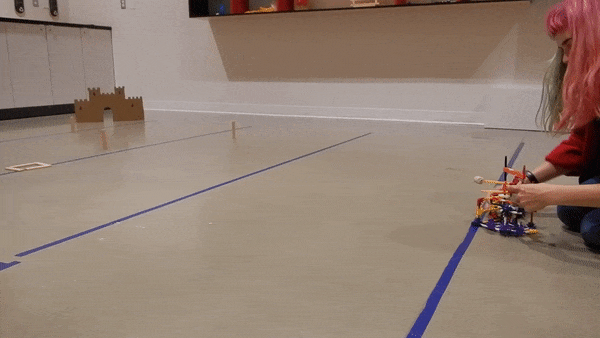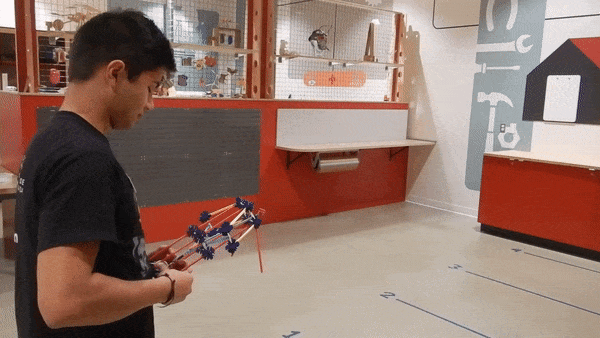3, 2, 1, GO: An Exploratek story
From the outside, Exploratek looks like a cross between a factory and Santa’s workshop. This tinkering space — located inside the Canada Science and Technology Museum in Ottawa — has cabinets brimming with materials and tools. This is the place to go if you want to pull things apart, put things together, make things move, make things light up, and create anything you can dream up.
Every time a museum visitor walks into Exploratek, they are presented with a challenge. As an employee at the Canada Science and Technology Museum, I do all kinds of crazy projects on a day-to-day basis. And on one fall day, I was given an Exploratek challenge too! My Exploratek mission seemed simple at first: design and build a simple machine to launch a projectile across a ‘battlefield,’ and knock down a castle (that may or may not be guarded by an evil wizard).

The battlefield
I chose to base my design off of something that pirates, medieval knights, Leonardo da Vinci, and the Canada Science and Technology Museum have in common…catapults!
What’s a catapult?
A catapult is a simple machine that moves objects through the air. Catapults were originally designed for use during battles or wars. These days, they are used for a variety of reasons, from toys to pumpkin tossing, and even launching planes and jets from aircraft carriers that have limited runway space.

A Lego catapult, a pumpkin toss competition, and an airplane launched using a catapult from an aircraft carrier.
The catapult arm is what transfers the energy from the stored energy (in this case, a stretched elastic band) into the kinetic (or movement) energy of the projectile. When you pull back on the catapult arm, you stretch the elastic, storing potential energy. When you let go, the stored energy is released, converted into kinetic energy, and transferred to the projectile which flies through the air.
How I built my K’NEX catapult
Testing phase
After recruiting some help from a couple of the museum guides, testing began.
On the first test, the projectile failed to cross the entire battlefield. Clearly, I didn’t have enough kinetic energy. To get more kinetic energy, I needed more potential energy. Thus, more elastics!

The second time the cork (our projectile) flew straight across the room – great!! The only problem now was accuracy. The cork went waaaaaaay too high. So, we made some adjustments to the angle of the launching arm and the “blocker” rod on our catapult, and tried again!

So close! But if at first you don’t succeed….try, try again!

Finally…SUCCESS!

A sideways catapult?
Having successfully besieged the castle, the guides and I turned our attention to other kinds of siege weapons. We wondered if it would be possible to fling a projectile sideways, just in case you needed to launch a projectile under something.
Once we finally got it to stay together, it was once again time for testing! Unfortunately, no amount of tinkering could get our catapult to fire very far.

It did however, work very well as a battering ram!

Creativity and Design
It all started one day by asking how to make a simple catapult. Before we knew it, we had amassed a whole collection! Visitors and guides in Exploratek have been experimenting with tension, length, and size, and in doing so have created a variety of siege engines.

Here we have: a working trebuchet (blue arrow), driven by the potential energy of gravity (not elastic bands), a compact catapult (orange arrow), which was arguably the most powerful catapult in the room, and a mobile catapult (green arrow), just in case the wizard teleports their castle to a new location.
My personal favorite launching device: the working K'NEX crossbow. Simply wind up the elastic band and release the arrow with a surprisingly scary amount of speed! I don’t know who made this, but I have mad respect for them!

Final thoughts
I intended to spend about an hour in Exploratek, but I ended up being so into the challenge (and the follow-up challenges!) that I was there for almost three hours. I think the open-endedness of this challenge was what made it so appealing to me. The launcher experiment is deceptively straightforward: build a machine that will throw a cork across the room.
The solution to the challenge can be very simple to construct, or so technical that it could keep a professional engineer occupied for hours! I had lots of design problems throughout the process, but the nature of the challenge had me re-designing, creating and testing hypotheses, collaborating with others, and evaluating outcomes.
Tinkering activities like these are important because it can help children (and adults!) understand how things are made, gives focused and unstructured time to explore and test ideas, and it's at the heart of invention and innovation. It just goes to show that encouraging critical thinking and creativity doesn’t require elaborate plans!
Want to try this activity?
3,2,1, Go! is one of Exploratek’s most popular weekly challenges, and it pops up in the schedule pretty regularly. If you’re interested, check out Exploratek. Or drop by the Canada Science and Technology Museum to check out the challenge of the week.
Do try this at home!
Alternatively, you can build elastic band catapults with lots of objects found around the home. Experiment with lego, popsicle sticks, pencils, tinker toys, pop cans, cardboard, or whatever you can find! Search the basement, recycle bin, junk drawer, and garage for items you can use to construct your catapult. Small items like candy, a ball of aluminum foil, pom poms, marbles, pieces of lego, or corks make great projectiles. Just make sure you’re launching in a safe environment where you won’t hit anything (or anyone!) other than your intended target. We’d love to see what you come up with! Tag us on social media, using #Exploratek
And remember, ask lots of questions! Here’s some to get you started:
● Does a wad of paper go the same distance as a ping pong ball? How about a marshmallow?
● How many elastics can you add to increase your flight distance?
● What if you add a second plastic spoon to make a double-launcher?
● What would you change (lengthen, shorten...?) to make the projectile fly further?















































